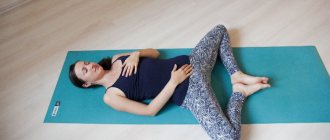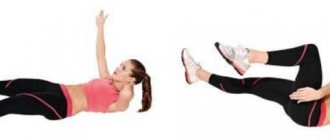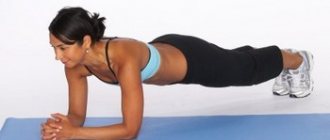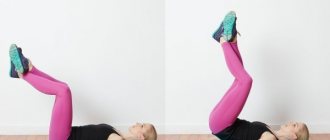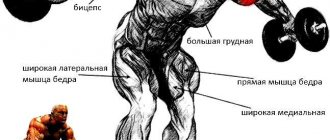"Scissors"
Sitting sideways on a chair, take the V-stabilization position: leaning back slightly, stretch your legs up, rest your hands on the chair seat. While maintaining this position, work your abdominal muscles and, as you exhale, lower your legs one by one until they are parallel to the floor. Perform 8-12 movements with each leg.
Side plank leg raise
“Lie down” on the chair with your right side (back to back), placing your pelvis on the seat. Place your right hand on the floor and extend your legs above the floor. Open your chest, squeeze your shoulder blades together. Tighten your abdominal muscles and buttocks, connect your inner thighs, feel the stretch throughout your entire body, from the top of your head to your feet. Exhale, lift one leg, maintaining a neutral position, and inhale, lower it to the starting position. Perform 8 repetitions of the movement in each direction.
Body tilts
Sit on a chair with your back pressed against its back. Bend your arms, spread your elbows to the sides and place your fingers on the back of your head. Having fixed your pelvis and lower back, while inhaling, lower your left arm down and bend your upper body to the left. Exhale and return to the starting position, performing 8-12 repetitions in each direction.
Chair games for children
What do you need for a fun game? The main thing is a good mood. But sometimes you can use some auxiliary items. I decided to devote my next review of games for children to games with chairs. There are definitely chairs in every home, which means nothing can stop you from having an evening (or day, depending on who you like) of “chair” games.
Who's the odd one out?
This is perhaps the most common game for children that involves chairs, but that doesn't make it any less popular or fun. In any case, when Stepka’s friends come to visit us, we often play it with pleasure.
Chairs are placed in a circle (one less than the number of participants). The players stand next to the chairs and, at the leader’s signal, begin to walk around them. Suddenly the presenter gives a signal - for example, clapping his hands. As soon as the players hear this signal, everyone must sit down on a chair. But, since there are fewer chairs than players, one is left without a chair and is eliminated from the game. At the same time, a chair is also taken out of the circle (so that there are again one more players than chairs) and the game continues.
When only two players and one chair remain, the final stage of the game is played and the most dexterous and cunning player is revealed - the winner.
Waves
It is advisable that many players take part in this game, because it is difficult to move around in a small circle.
So, the chairs are placed close to each other in a circle. There are as many chairs as there are players. One of the players (the leader) stands in the center of the circle. This leaves one chair free. The presenter gives the commands: “Right” or “Left”. Players follow commands and move to adjacent chairs. The presenter’s task is to have time to sit in an empty chair. You can't push each other away.
When the leader takes a chair, the player who is without a chair becomes the new leader.
Sometimes we make the game more difficult and add the Chaos command. During it, the players must quickly change places, and the leader must take the place of one of them.
Recently we came up with a more tricky version of the game - we install chairs with their seats facing outward rather than inward. And the presenter has to run much faster to take an empty seat.
Prisoner and guard
You need to form a circle from the chairs and place two players in the center. One of them is blindfolded - he is a guard, the other has his hands and feet tied with ribbons - he is a prisoner. The remaining players stand behind the chairs and, carefully stretching out their hands, try to untie the prisoner. The Guardian must prevent this. He doesn't see anything, but he must sense where the threat is coming from and insult the liberator. If the guard touches him with his hand, the liberator is eliminated from the game.
The player who unties the last knot and removes the captive's ribbon becomes the guard in the next game.
Get up from your chair
Styopka really loves this game for children because she knows what the trick is and always wins. This is not a simple game, but rather an argumentative game.
Styopka argues that the man will not be able to get up from the chair. At the same time, he says that he will not interfere with the player, tie him up or put him on some tricky chair.
Of course, friends are getting along and then Styopka announces a small condition. The player must sit on a chair so that his back is straight and touches the back of the chair, and his legs are standing exactly at an angle of 90. And now, the player must stand up without changing the position of his legs and without bending his body forward. No amount of muscle effort will allow anyone to get up from a chair! Unless, of course, you move your legs under the seat or tilt your body forward - but this is prohibited by the rules.
And everything is explained by a simple physical law. The center of gravity of a sitting person is near the spine. If you mentally draw a vertical line from this point down, it will pass exactly under the chair, behind your feet. And in order for a person to stand, the center of gravity must be between the feet. So it turns out that you need to move the center of gravity (move your legs or tilt your torso).
Take a seat
And again we arrange the chairs in a circle, and leave one free. The driver stands in the center. The one sitting to the left of the empty chair starts the game. He hits an empty chair with his right hand and loudly says the name of one of the players. The one who was named quickly runs to an empty chair and takes it. And the driver is trying to overtake him and be the first to take an empty chair.
If the driver did not have time, he returns to the center of the circle again. And the player to the left of whom there is an empty chair says the name of the other participant and hits the chair. The game continues and if the driver manages to be the first to take the chair, the participant who did not have time to reach the chair takes his place.
Fair
It is advisable that the driver in this game be an adult (not all children find it easy to write a story).
The chairs are placed in one straight line at a certain distance from each other. Children sit on chairs.
First choose a topic. For example, a fair. Each player is assigned the name of an item that is being taken to the fair. For example, “basin”, “trough”, “boots”... The presenter must remember the name of each person-object. Then the presenter begins a story about how he gets ready for the trip and what he takes with him. As soon as the player hears the name of his item, he must jump up and run around his chair. If you hesitate, you must give away some kind of forfeit (handkerchief, sock, bow).
At the end of the story, the presenter says key words (they need to be agreed upon at the beginning of the game), for example: “The fair is closing.” The players get up from their chairs and disperse around the room. But when the presenter says: “The fair is closed,” everyone must run to the chairs and take their seats. The presenter does the same. The player who does not get a chair is considered a loser.
If at the end of the game a sufficient number of forfeits have accumulated, you can arrange a draw. To get the phantom back, the player must complete some task (for example, grunt or sing a song).
Pull out the string
This game for children is a competition for two players. They sit on chairs with their backs to each other. The chairs are placed at a distance of approximately 2 meters from each other. There is a rope under the chairs.
At the leader’s signal, players must stand up, run first around their chair, then around the opponent’s chair, then return to their chair, sit down, bend over and pull the rope. Whoever does it faster wins.
Before the start of the game, you need to agree that each player runs in his own direction so that they do not collide heads in the heat of battle.
frogs
This game will require a little more free space. The chairs are placed in one straight line, at a distance of approximately 0.5 meters from each other and 3 meters from the participants. It turns out that each participant stands opposite his chair.
At the leader’s command, the players squat down and jump. You need to jump to the chair, go around it and come back. The one who returns first is the winner.
Don't slouch if you want to be healthy!
Do you often “catch” yourself sitting slouched? Do you often experience back pain, neck pain, or aching shoulder blades?
Working all day on a computer in the office and at home, I began to physically notice my crooked back and back pain. Today we’ll look at what to do to avoid slouching and maintain your health. What impact does posture have on our health and how to stand and walk correctly, I wrote in my previous articles: “Show me your posture, and I’ll tell you what hurts” and “A crumpled shoe or loose panther plastic.”
We continue the topic of posture, and today we will learn how to sit correctly and maintain the correct position of the spine while sleeping.
How to sit correctly
Look around, observe how most people usually sit? The back is hunched, tilted to the side, the neck is stretched forward, the legs are crossed over the legs. In the age of computer technology, this position is often found not only in adults, but also in most children! Basically, posture deteriorates due to the habit of sitting incorrectly in childhood.
In a sitting position, the pressure on the intervertebral discs is twice as much as in a standing position. This is why it is very important to pay attention to how we sit.
So, what can you do to avoid slouching? It is important to learn how to sit correctly and get up from a chair correctly. There are several important points here.
- The back of the chair should follow the curve of the spine and be rigid. Press your back against the chair, do not relax your stomach, straighten your shoulders, raise your head. Until you learn to keep your back straight, do not sit on stools.
- The seat of the chair should not be longer than the hip. Otherwise, the edge of the chair will put pressure on the arteries under the knees.
- Adjust the seat height of the chair so that your feet are straight on the floor. The chair should not be too high or too low.
- Avoid overly soft seats. The intervertebral discs are subject to greater stress on them.
- Sitting cross-legged is not safe. This can cause pain in the lower spine and lead to illness.
- When sitting for long periods of time, take breaks and stretch your spine.
And now a simple exercise to relieve tension from the cervical spine: lower your chin to your chest, bring your shoulder blades towards each other as close as possible. Do this exercise during the day when you are at the computer for a long time.
- Train yourself to pull your stomach in and hold it under any circumstances. In this position, you involuntarily bring the lower part of the spine into the correct position.
- Swim! For perfect posture, it is best to swim on your back. In this case, absolutely all the back muscles are involved, the neck is completely relaxed, the back is in a horizontal position.
Learning to sit down and get up from a chair correctly
It turns out that this is also important for our spine!
- Sit down on the chair carefully, do not flop down with all your might. This causes enormous damage to the vertebrae; the impact wears out the cartilage plates and discs.
- Sit down on the chair gently, point your head forward and up, relax your neck, straighten your back.
- When sitting on a chair, pull your head up, transferring your body weight to your hips, ankles and feet.
- When standing up, push your body up without supporting yourself with your arms. Pull the top of your head up. Imagine that you are floating up like a cork, softly and easily. This way you will not only learn how to stand up beautifully and correctly, but also keep your back straight!
At first it will be incredibly difficult to sit correctly. The back will strive to return to a “comfortable”, familiar position. After all, you have been sitting wrong for so many years! But very soon your body will get to know and love the new position, your back will respond with health, and everyone will turn to look at your posture. And this is very nice!
How to sleep properly
We spend a third of our lives in bed! Therefore, your body position during sleep and what you sleep on are very important.
- The mattress should be hard, flat, but elastic. A soft, sagging mattress does not provide adequate support for the heaviest part of the body – the pelvis. This is how the spine curves in the direction on which you sleep. A hard mattress forces the spine to arch in the opposite direction. A firm but elastic mattress allows the body to develop its natural curve.
- The pillow should be small, soft, rectangular. It allows you to keep your upper spine in a perfectly straight position. The muscles of the neck and head completely relax during sleep.
If you sleep on your back, your head should be on the pillow and the edges of the pillow should be above your shoulders. If you sleep on your side, then your shoulder should be on the mattress and your head on the pillow.
- During sleep, try to adopt a body position so that one part of the body does not put pressure on another. This interferes with normal blood circulation. Also, sleeping on your back and stomach deforms your spine.
- Relax your facial muscles. When they are tense, the cervical vertebrae also become tense. Remember something pleasant and relax!
Of course, you cannot fix in one day what has been ignored for years. But daily use of these simple steps will help you make your posture beautiful and be physically active until the age of 90 and look 30 years younger!
And remember, being healthy and slim is easier than you think!
To improve your nutrition and sports system, to always be healthy and energetic, in great shape and in a great mood, sign up for the “Victory!!!” program. Pintosevich Body Design™!
If you have inspiring stories, ideas and a desire to collaborate with the best platform for personal growth, write to us by email or Facebook Messenger.
Raising the leg from the “Extended bridge” position
Lying on your back, place your feet on the seat so that your legs are straight. Lift your pelvis off the floor, resting only on your feet and shoulder blades. Working the muscles of your buttocks and abs, stretch behind your feet and the top of your head. While holding this position, as you exhale, lift your legs up one at a time. Perform 8-12 movements with each leg.
Want to learn even more chair exercises? Visit our video library and turn on the Pilates lessons. Morning" with Leonid Zaitsev.
Set of exercises
Simple abdominal exercises on a chair are available to everyone. They can be performed by both women and men, regardless of their weight and age. The complex is quite easy, but for those who have not previously played sports, at first it may seem simply unrealistic. This feeling will disappear after a week of regular exercise.
To perform the complex, you will need a very ordinary chair with a back, but without arms. If it is comfortable to sit on, then it is quite suitable for performing some other actions.
Experts identify the following exercises for the press while sitting on a chair as the most effective:
- With a straight back and tense buttocks, take a deep breath and draw in your stomach as much as possible, hold your breath for 5-8 seconds, then exhale and relax. In total you need to repeat 30 times.
- Move to the edge of the chair, rest your hands on it and stretch your straight legs forward. Alternately, you need to bend your legs and pull them to your chest, and then return to the original position. This exercise is performed 6 times on each side.
- Without getting up from the edge, you should place your hands slightly behind the body and lean back so that you can feel the support well. In this case, your legs must be lifted off the floor and bent at the knees. You need to simultaneously pull your legs towards your chest and lower them down, or straighten them in front of you. This should be done without touching the floor. During the execution, your arms should under no circumstances strain, as this will cause the abs to not receive sufficient load. This exercise must be done 20 times.
- Turning sideways to the back of the chair, you need to grab it with one hand, tilt your body back as much as possible and stretch your legs forward. You need to rise up smoothly, simultaneously pulling your bent legs towards your stomach, and then return to the starting position at the same pace. A total of 15 repetitions are recommended.
The number of repetitions in these exercises is indicated for beginners. This applies to both beginner athletes and people who have already played sports before. As soon as it becomes easy to perform them, you need to increase the number of approaches or add the number of repetitions. This is done based on how you feel.
"Fold"
Take the starting position of the previous exercise. Keeping your back straight and working your abdominal muscles, as you inhale, smoothly lower your legs and body, and as you exhale, return to the starting position. Repeat 8-12 times.
Shoulder bridge
Lie on the floor, place your feet on a chair so that the angle of your knees is approximately 90 degrees. Take a neutral body position (we wrote about how to do this), with your arms along your body, palms down. As you exhale, gently lift your pelvis, twisting your lumbar spine and rounding your thoracic spine. Lock yourself at the top, maintaining one straight line from your knees to your shoulder blades. Leaning on your shoulder blades and shoulders, keep your buttocks and stomach tense. Inhaling, also smoothly lower yourself to the starting position, starting the movement from the thoracic spine. Perform 8-12 repetitions of the exercise.
Exercises with a chair for beautiful abs
To complete this exercise you will need:
- exercise mat;
- stable chair.
Starting position: lying on your back, legs bent at the knees, lying on a chair. Clasp your hands and place them on the back of your head.
You can do sit-ups with your feet on a chair, but it's your abs that have to do the work! That is, to lift, we strain exclusively the abdominal muscles. The neck is relaxed.
It is easy to pump up the lateral muscles if, when lifting, you stretch your right elbow to your left knee, and your left to your right.
You can also use your legs to work your lower abs and thighs, as shown in the video below.
You need to start with about 10 lifts and 2 approaches per day. Then you can increase the number of approaches.
Body rotations
Sitting in the starting position of the previous exercise, gently twist your chest to the right, then to the left. Make sure your pelvis and lower back are supported. Perform 8-12 turns in each direction.


